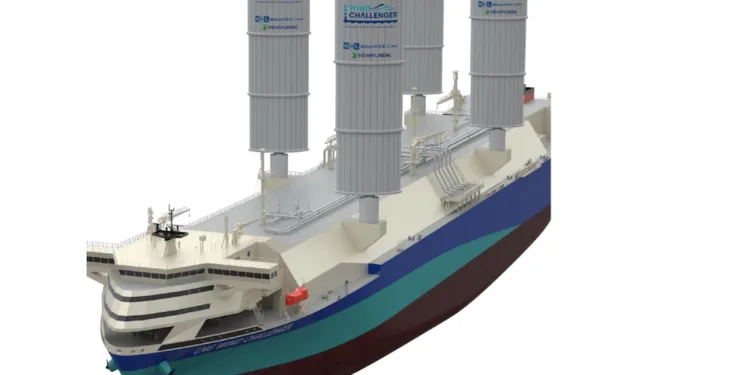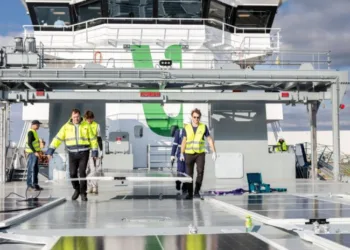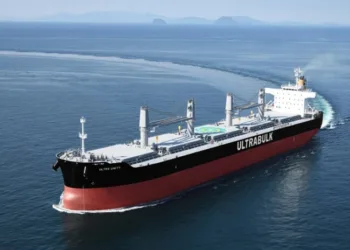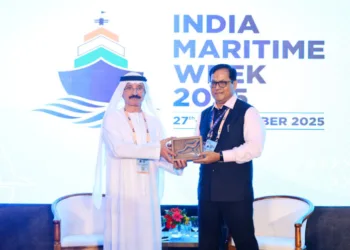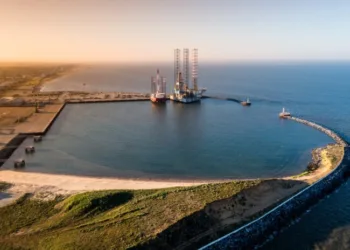Pierre Aury issues some principle disapprovals over some new LNG ship designs he’s come across recently.
A few weeks ago, two pieces of information caught our attention. The first one is about Mitsui OSK Lines (MOL) obtaining an approval in principle from Lloyd’s Register (LR) for a new design of a membrane-type LNG carrier equipped with four hard sails (pictured). The second one was about Samsung Heavy Industries announcing at the opening of Gastech in Milan last week that it had received an in-principle approval from the American Bureau of Shipping (ABS) for a 174,000 cu m LNG carrier to be powered by a small nuclear modular reactor (SMR). 174,000 cubic meters of LNG with an average density of 0.6 equates to about 105,000 metric tons of LNG.
Regardless of its final use (electricity generation, heating, cooking), methane ends up for its most part being burnt. One ton of methane being burnt releases 2.75 tons of CO2 in the atmosphere.
A cargo of 105,000 tons of LNG will therefore generate just shy of 300,000 metric tons of CO2, plus, of course, CO2 emissions related to liquefaction, re-gasification, transport and emissions of methane referred to as the methane slip – basically methane going through the main engine and not being burnt in the process.
Methane in itself is a very potent greenhouse gas. The range of daily main engine consumption in tons HFO equivalent is between 50 and 90 tons per day, depending on the technology used (2-stroke low rpm engines at one end and 4-stroke medium rpm engines coupled with electricity generators and electric motors at the other end).
Taking an average of 70 tons per day for a 30-day round voyage means that a total of 2,100 tons of equivalent HFO is consumed and 6,300 tons of CO2 (2,100*3= 6,300 as one ton of HFO burnt emits three tons of CO2) is emitted by the LNG tanker during that round voyage. These 6,300 tons of CO2 are about 2% of the above-mentioned 300,000 tons of CO2. So, assuming we go nuclear, LNG shipping will be proud to have saved 6,300 tons of CO2 emissions per voyage in order to enable the emission of 48 times more CO2 (300,000/6,300) when the LNG cargo arrives at destination.
With an LNG tanker orderbook standing at 44% of the existing fleet, driven by a global gas demand predicted to increase by 20% by 2050, the numbers are becoming mind-boggling.
Based on six trips a year per ship for 100 newbuildings, Mother Earth will thank shipping for avoiding an extra 3.8m tons of CO2 (6,300*6*100= 3,780,000) being pumped into her atmosphere, while at the same time the LNG carried will, when burnt, release a cool 165m tons of CO2 (0.16*2.75*100= 165). -3.8 +165 – is shipping being taken for a self-inflicted ride?
All of the above is based on nuclear-powered LNG tankers, when no one knows what happens if a ship carrying 174,000 cu m of LNG is involved in a major accident: the creation of a massive ice cube or a massive explosion, or a combination of the two? So, for good measure, let us add a nuclear reactor into the mix.
If LNG carriers are assisted by sails for their propulsion, of course, all of the above calculations, CO2 emissions saved versus extra emissions, become even more ridiculous, with only 30% of fuel saved at best, with some sources putting the saving at an even lower 17%.
We live in a marvellous world of contradiction in which we are shipping CO2 emissions wise and natural gas CO2 emissions foolish.



